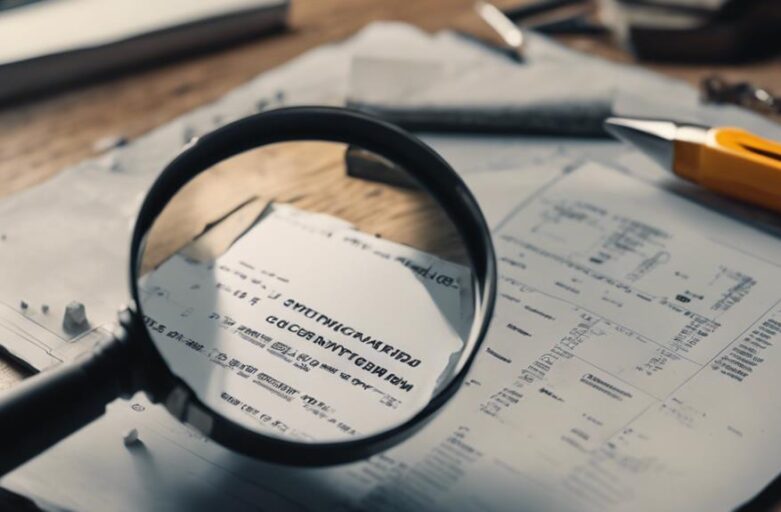Building a strong and lasting structure needs good quality materials. This means you have to check and test everything you use. You have to make sure that all the materials are safe and won't harm the environment. You can do this by working with experts, using special tests, and even computer programs.
When you do this right, you can be sure that your building will be strong, good for the environment, and follow all the rules. It's like solving a puzzle – when you know how to deal with any problems that come up, and plan well, your project will go smoothly.
There's a lot more to learn about how to check and test building materials, and it's really interesting. Go ahead and start learning more about it!
Key Takeaways
- Check if the building materials are of good quality and can last a long time. They should be as good as what the project needs.
- Look for any broken or damaged parts in the materials. These could make the building unsafe.
- Make sure the materials match what the project needs specifically.
- Look at if the materials are earth-friendly. This helps to build in a way that doesn't harm the planet.
- Think about how the materials might affect the environment. This includes how much waste they make and how much energy they use.
Understanding Building Material Inspection
Understanding how building material inspection works is pretty cool. It's all about double-checking the materials used in a construction project, making sure they're strong enough, safe, and environmentally friendly. It's not a quick look, but a deep dive using several tests.
Quality control is a big deal here. Materials need to not just look good, but also meet high standards. This is how we ensure that each brick, wooden plank, or metal beam is just right. When we build structures, we're also building trust by making sure everything is as it should be.
Sometimes, outside inspectors are brought in to help with these tests, giving us an added level of confidence. Even computer programs are getting in on the action, using past data and virtual models to predict the quality of materials.
In the world of building material inspection, quality is a must. It's about being precise, respecting the rules, and striving for the best in every project.
Evaluating Material Quality and Compliance
After you have carefully checked all the building materials, it's time to assess their quality and how well they match the needs of your project. Consider things like your project's design, how the building should perform, and safety rules. Making sure your materials are top-quality is crucial for your construction project to be successful. The better the materials, the longer and safer your building will be.
Don't worry, you're not alone! You can work with architects, engineers, and suppliers to make sure your building materials are just right for your project. They can give you helpful advice on how strong and safe these materials are. Remember, a successful project is a team effort.
As you evaluate your materials, look at all the rules, standards, and laws that apply. Aim to do more than just meet the basic requirements – go for the best quality you can. Think about how energy-efficient and sustainable the materials are. But, we're not talking about environmental rules in detail right now.
As a member of the construction community, we all aim for top-quality construction. Let's make sure that every material we use is the best it can be. By doing this, we're helping to make a safer and more efficient future.
Role of Environmental Compliance

Environmental compliance is like the superhero of the construction world. Its mission? To save the environment from harm during building projects. This means making sure every action during construction follows rules meant to reduce harm to the environment.
Think of it like a protective bubble around air, water, and soil on a construction site. It's about taking steps to keep these crucial parts of our world safe. This includes managing waste properly and stopping pollution before it starts.
Plus, being environmentally conscious is smart for business too. It can help avoid costly fines, dodge penalties, and keep your project on track. It's like scoring a big win for both your project and the environment!
And there's a bonus! By using building methods that are friendly to the environment and save resources, you're not only following the rules – you're setting a great example! It's like being a leader in caring for our planet while building for the future.
Documenting Utility Coordination
Diving into utility coordination documentation might sound like a big deal, but it's actually pretty cool. Let's break it down so it's easy to understand.
This process is super important for making a project work, and that's what we're going to chat about. We're going to learn the steps, face any tricky parts, and see how it makes your project shine.
Ready? Let's jump in!
Importance of Utility Coordination
When you're working on a building project, keeping track of utility coordination is a big deal. It's like a secret weapon that makes sure everyone is talking to each other and keeping track of all the work, tools, and materials. This is a common practice in the building world and it's a key element that makes projects run smoother and be more successful.
Think of inspection reports as a diary of your project. They show the real worth of old materials and what you can get back for them. They also point out special things that affect how well your work goes, giving you a guide on how to get better.
Plus, keeping a record of work that's been done is important if you want to get paid back. This helps keep everyone responsible in your project. So, it's a good idea to use utility coordination. It's not just a step in the process, but a tool for creating a strong and honest way of doing things.
Steps in Utility Coordination
Now, let's learn about the steps to organize and record utility coordination, which is just as important as the actual building work.
First, make sure to write down the communication between the contractor and the utility companies. This is really important for your project. Check the project files to make sure everything from workers' time, machinery, and materials used are recorded correctly.
Also, check how they manage old or risky materials to ensure they're doing it in the safest and most cost-effective way. Make note of any unique aspects that could affect the cost and efficiency of utility coordination.
Lastly, make sure the contract units built are correct and if there are any differences, sort them out quickly. Following these steps will help you manage utility coordination effectively, saving you both time and money.
Challenges in Utility Coordination
Understanding how to record utility coordination can be tricky, but it's a very important part of managing a project. It's key to make sure everything is strong and safe, follows building rules, and uses the right materials.
| Problems | Solutions |
|---|---|
| Making sure coordination efforts are correct | Create a strong checking process |
| Checking project records | Use a really good system to manage documents |
| What to do with old materials | Set up a system to judge their worth |
| Looking at special features | Use smart software to see and understand these parts |
Managing Structures and Obstructions
So, how can you manage obstacles and buildings in your project? It's all about following the rules, keeping track of everything, and sticking to what your project's contract says. Do you want your project to be successful? Then you need to pay attention to these important parts of your project.
First, if you remove any buildings, make sure you get rid of them according to the contract. This isn't just to keep the site clean, but to make sure your project meets all the necessary rules. After that, think about harmful materials. You can't just throw them away anywhere; you need to write down what they're and dispose of them correctly. This is a crucial part of managing buildings and obstacles that people often forget about.
When it comes to the money the Federal government gives for the value of what you can salvage, you have to make sure you credit this properly, just like your project's contract says. You can't take shortcuts here – it's all about being honest and following the rules.
Site Preparation Considerations

Before we start, let's talk about the important steps you need to take when preparing a site. Think of this as creating a strong base for your dream project.
Firstly, you need to know where you can and can't clear. Make sure to keep safe anything you want to stay untouched. It's like outlining a soccer field – it changes everything.
Secondly, make sure there are ways to control erosion on your site. When you're building, you're also looking after the environment. So, it's important to have steps in place to stop soil from washing away. It's not just about finishing the project, but doing it in a way that's good for the planet.
Also, don't forget to check your soil report. Knowing what kind of soil you have and what it's like is very important for preparing your site. It's like getting to know the personality of the land you're working with.
Conclusion
Great job! You've learned how to check and rate building materials to ensure they're top-notch and meet all the rules.
You understand the importance of following environmental rules and the need for coordinating utilities.
You're ready to manage buildings and obstacles, and to think carefully about preparing the site.
Now, dive in, use what you've learned, and start building with certainty, precision, and enthusiasm.
Don't forget, every awesome building begins with detailed planning and thorough checking.


